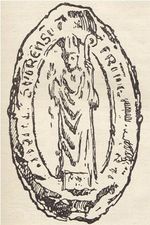Friedrich von Bolanden
Friedrich von Bolanden (* in the 13th century; † January 1302 ) was bishop of Speyer from 1272 to 1302 .
Live and act
Friedrich von Bolanden came from the Bolanden ministerial family , his parents were Werner IV von Bolanden and his first wife Kunigunde von Leiningen , a sister of the episcopal predecessor Heinrich von Leiningen .
In 1276 the bishop was captured by Knight Wolfram von Fleckenstein and imprisoned in his castle. King Rudolf von Habsburg therefore besieged Fleckenstein Castle and freed it. During his absence, Albert von Mußbach, dean of the cathedral, represented him in Speyer . During this time without a bishop, the city of Speyer tried to appropriate various rights of the diocese. The main point of contention was the ungeld . Domdekan Mußbach complained to Pope Johannes XXI. Even before the papal decision was made, the cleric was brutally murdered near the Speyer Cathedral . The killers were never caught. Bishop Friedrich von Bolanden stated that Albert von Mußbach had "stood up like a wall to protect the house of God and eagerly for justice in everything" .
In 1297, Bishop von Bolanden founded the village of Wiesental near Waghäusel .
The 1903 annual report in the communications of the Historical Association of the Palatinate, booklet XXVI, states in a section about the graves archaeologically examined in the Speyer Cathedral that Friedrich von Bolanden was one of the few Speyer bishops who were not buried in the cathedral. His grave is in the Eusserthal monastery .
The Trier canon and archdeacon Heinrich von Bolanden († 1286) was his brother; Anna von Bolanden († 1320); Cistercian woman in the Kirschgarten monastery (Worms) , from whose possession a valuable codex has been preserved, a niece of the bishop (daughter of his brother Philip V von Bolanden).
Werner von Bolanden († 1324), a nephew, officiated as canon in Mainz or Speyer , as well as the Speyer chair brother provost and provost to St. Viktor before Mainz .
coat of arms
The prince-bishop's coat of arms is usually quartered . The fields of the coat of arms alternate with the family coat of arms of those of Bolanden and the coat of arms of the diocese of Speyer, a silver cross on a blue background. The von Bolanden family coat of arms is a red wheel with six spokes on a gold background.
See also
Web links
literature
- Hans Ammerich : The diocese of Speyer and its history , Volume 2: From the Staufer period (1125) to the beginning of the 16th century ; Kehl am Rhein 1999; ISBN 3-927095-44-3 . P. 21.
- Hans Ammerich : Friedrich von Bolanden , in: The Bishops of the Holy Roman Empire 1198 to 1448. A biographical lexicon, ed. by Erwin Gatz and Clemens Brodkorb, Berlin 2001, pp. 745-746.
- Franz Xaver Remling : History of the Bishops of Speyer , Volume 1, Mainz, 1852, p. 526 u. 527; (Digital scan)
- Konrad von Busch and Franz Xaver Glasschröder : choir rules and younger sea book of the old Speyer cathedral chapter , Historical Association of the Palatinate, Speyer 1923, p. 153 u. 154
Individual evidence
- ^ Franz Xaver Remling : History of the Bishops of Speyer , Volume 1, p. 520, Mainz, Verlag Kirchheim and Schott, 1852; Google Books
- ↑ Historical website for the foundation of Wiesental
- ^ Family genealogical website
| predecessor | Office | successor |
|---|---|---|
| Heinrich von Leiningen |
Bishop of Speyer 1272–1302 |
Sigibodo II of Lichtenberg |
| personal data | |
|---|---|
| SURNAME | Friedrich von Bolanden |
| BRIEF DESCRIPTION | Bishop of Speyer |
| DATE OF BIRTH | 13th Century |
| DATE OF DEATH | January 1302 |

